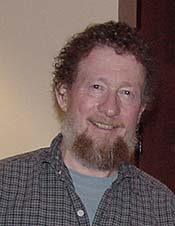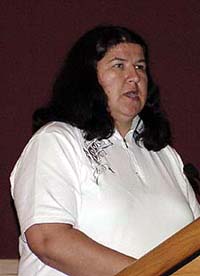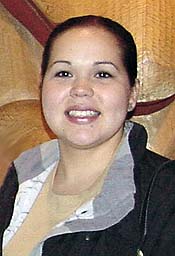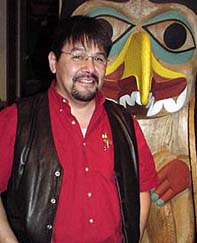 Celebrating National American Indian Heritage Month Story & photos by Gigi Pilcher November 18, 2002
John T. Autrey, archaeologist with the Misty Fjords Ranger District, Tongass National Forest, began the evening's presentation by saying, "It is a special honor to speak about the First Peoples of the Tongass, the People of this Land, about their history and some of the very special cultural values and achievements which continue to provide everyone in our respective communities reason to have great pride." He followed his comment with a quote from Frederica de Laguna who once said, "We dedicate this day to the greatness of your ancestors, and to bright hopes of your children and grandchildren." Autrey's presentation began with a narrated slide show which also included the re-telling of a story as told by Charles Brown. 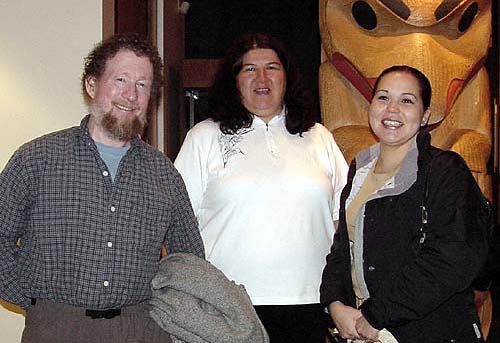 Regarding the arrival of The First People Autrey said The First Peoples of the Tongass arrived at least 10,000 years ago as verified by contemporary archaeological studies. He said, "however, the people of this land will say that they have continuously used and occupied and continue to be the stewards of the lands and waters of Southeastern Alaska and have been here from time immemorial. The Tlingit, Haida, and Tsimshian people have their own stories." On the topic of origins (Lake Shelokum), Autrey said the origins and commonalities of the Tlingit, Haida, and Tsimshian peoples have been much discussed and studied. He remarked that every clan has their own story regarding the Clan's origins and their migration stories. Autrey said some origin stories begin before and some after the great flood. Autrey told a story by Charles Brown which was told to Linn Forest about the flood.
Autrey said it is after this flood that the clans developed. He said, unity and solidarity were emphasized by the obligation to share food and property and by helping one another which can be said for all the Native peoples. He said, the flood separated people from one another and the survivors migrated back to the coast from the interior and spread out to many places in Southeastern Alaska. Autrey spoke about crests and myths saying the ancestors and the clan destiny were and are considered sacred. He said, clan crests, songs, dances and myths are owned by the clan
Regarding respect and dignity, Autrey said the Southeast Alaska Native society of the 1700's emphasized respect, proper conduct, self-constraint, and dignity, and was sensitive to ridicule and public embarrassment. Elders earned prestige because they had acquired greater knowledge, wisdom, experience and spiritual purity. The shame of insults to a person or improper conduct were shared by all clan members and likewise, a person's accomplishments reflected on all members of the clan, he said. On the subject of Atoo, ownership of resources, Autrey said the Tlingit, Haida and Tsimshian form of government cannot be separated from the extended family or clan unit. The clan held property in common as a family, which is called "Atoo'. He remarked, this property represented the family unit, prestige, status and rank. No one spokesman represented all of the clan, tribe or nation. Each house group did have one spokesman who represented them and their rights and ownership and use of certain berry patches, hunting areas, salmon streams, ceremonial objects, names songs, and crests. A strict legal system was based on tradition. Geographic areas were carefully delineated and ownership by particular families was well known. The traditional form of government was displaced during the Russian and American colonization of Southeast Alaska, Autrey said. Commenting on the Tongass Village site, John Autrey said the authorization and requirement to protect cultural properties that have significant importance to the American people was established in 1966 with the enactment of the National Historic Preservation Act. During 1992, amendments to NHPA, provided broad authority for Federal agencies to protect specific site location, and information about sites if such disclosure risked harm to resources or impeded traditional beliefs. Autrey said many recent NEPA programs have been controversial regarding the management of public lands and the potential impacts on the various natural and cultural resources located there. He said often, people will speak of "sacred sites" located within or near proposed projects. To some, the entire earth is sacred or an entire mountain or island or valley or landscape. Autrey said, some "sacred" locations may be invisible to you and me but are real to the elder who is worried about protecting the places where the spirits live, or which has special meaning culturally but is intangible to most of us. The NHPA and other Federal legislation has specifically defined terms which Federal agencies must use in the legal sense while determining whether a site or cultural property is significant and how it is to be protected, Autrey said. He explained 'Traditional Cultural Property' as defined by the National Register Bulletin 38. He said 'Traditional' is used to refer to the "beliefs, customs, and practices" of a living community that are passed down through generations, through oral histories and/or through the practice of traditional skills. 'Culture' refers to the beliefs, practices, lifeways, and social institutions of any community. 'Historical properties' refers to the places of cultural, historical, ancestral, and spiritual value which NHPA requires federal agencies to identify, document, and evaluate their significance early in the planning (NEPA) for a project. Autrey remarked that one fundamental difference between sites that are considered a Traditional Cultural Property or a sacred site and other historic sites is that their significance cannot be determined without the consultation and participation of the Native people, the Elders and other knowledgeable people. An archaeologist or historian may have different perspectives from those of the native communities traditional values, he said. For instance an archaeologist or historian, will likely look for scientific or historical evidence and use the Federal definitions to document and formalize a sites' significance. Autrey noted that within traditional Native communities, the Elders are the respected keepers of traditional knowledge. The knowledge and opinions are considered the historic truth with in the Native community, he said. John Autrey concluded his presentation by saying, " We are trying hard to work together, closing the gap of what we know and how we can mutually define as areas of spiritual and traditional value, and to mutually find ways to protect these special places for the generations of the future." Merle Hawkins was the next guest speaker and Hawkins began her comments by introducing herself by sharing her Haida name Saandlaany.
After the traditional introduction, Hawkins said, "When the Federal government took Southeast Alaska for a forest reserve - later to become part of what is known as the Tongass National forest - it prompted the move of her ancestors from their villages". She said, "This was by mutual agreement and the Alaska Natives were given health care and the education that the government was obligated to give as part of their trust responsibilities. This was right after the small pox epidemics. The unique legal relationship between the Federal government and the Native Americans is founded on principals of constitutional, international, and common law, all of which lead to the conclusion that on a government to government basis Natives are to depend on Federal plenary power. They - Alaska Natives - are dependent on the Federal government to protect their aboriginal land and to provide important human services; they are dependent on the government to protect subsistence resources. This unique relationship is not based on race but on the U.S. Constitution." In identifying contemporary cultural resource management issues such as the saturation of Misty Fjords, Merle Hawkins said data is needed from Alaska Natives as to what their concerns are. She said that a major concern of hers is having Alaska Native Tribal input regarding the issues. "The Native Elders I have spoken to have a very different perspective
Upon concluding her presentation, Hawkins introduced Irene Dundas as the next speaker. Irene Dundas said, "I was asked to explain the relationship that the forest service has with the tribes and clan members in regards to cultural sites. I had thought how I would explain to you the meaning of what this means to our people.The relationship the forest service has with tribes is a very important role. The forest service is the caretaker of our land. Once we were the caretakers. I felt I could not explain this to you without giving you a story and a small insight into my life as some of the ways my people see things and why we feel so strongly about our land that is being taken care of by the forest service." Dundas introduced herself by saying, "My name is Ka Klaa Tlaa. I am Tlingit Tsaaqweidi Killer Whale of the Cedar House of Kake, Alaska. I was raised in Saxman but my home town is Kake. I have grown up with a strong sense of culture around me. In Saxman we danced and threw Potlatches. In Kake we subsisted and everyone spoke Tlingit. My late father was the leader of the Cape Fox Dancers so I learned how to sing and dance since I was able to walk." She said, "My mother grew up in Kake and I spent all of my summers there. Kake people call Kake "God's Country". This is because of the rich food supply. I started gathering berries with my grandparents when I was 4 years old. In late Spring we would pick seaweed off the rocks at low tide. You could find gumboots that are bigger than your fists, clams with buttons as big as quarters and the blackest seaweed that I have ever seen. Every time you go out winter fishing you always come back with winter king, and every time you go hunting for a deer you come home with a deer." Dundas said when she would visit her grandmother in the summer they would go to a place where they would camp out on the boat in a little inlet. She said her grandmother would tell her this is where our people (Tsaaqweidi) are from. Dundas said she remembered looking and thinking there was nothing there but an old iron stove, bottles and broken glass
Irene Dundas remarked, "That same tree that I use to gaze at, my grandmother's grandmother use to tell her that this was where the clan women use to birth their children at, hundreds of years ago. For some reason the Tsaaqweidi women use to birth their children under this three. Later, I understood why there were land otters there. In Tlingit land otters are spiritual animals so this place was sacred. They (otters) were guarding this place for the ancestors." Dundas said, "My Tlingit name is Ka Klaa Tlaa, which translates to 'the mother tree'. When another Tlingit person hears my name they know what clan I am from. My name explains the place in the Kake area where women birthed their children hundred of years ago." Dundas concluded her presentation by saying, "In the future, I hope that we are able to establish a management plan so we may educate the public and our own people to preserve cultural sites and resources, so stories like I shared with you may be shared with younger generations." After the presentation the audience had a opportunity to ask questions. The question and answer period lasted approximately half an hour.
Upcoming Events:
|
|||||
